#Hydroponic Farming at Home
Explore tagged Tumblr posts
Text
Find the Best Hydroponic NFT Channel | Inhydro

The Inhydro complete indoor hydroponic grow system is a great way to begin your hydroponic gardening journey. This system utilizes a Hydroponic NFT channel for its nutrient delivery method, ensuring that the plants get all the essential nutrients they need to thrive.
#hydroponic companies in india#Hydroponic Farming India#Hydroponic Farming at Home#Hydroponics Training in Delhi#Hydroponic Training Courses#Hydroponic Farming Equipment#Best Indoor Hydroponic Plants#Hydroponic Plants Indoor#Small Hydroponic System#Hydroponic Home Setup#Hydroponic Hobby Setup#Hydroponic Grow kit#Hydroponic NFT Channel
2 notes
·
View notes
Text
If you have been associated with farming or agriculture recently, you might have encountered the term known as hydroponics. It cultivates plants in nutrient-rich water, with any medium like soil, sand, or gravel.
Hydroponics is derived from the Greek word hydro, which means water, and ponos, which means labour. Together, they come as the cultivation that supports plant growth in the vertical position that holds the moisture and oxygen the plant will need.
#hydroponic farming#vertical hydroponic system#indoor lettuce grower#hydroponic farming at home#hydro farming#hydroponic container#best vertical hydroponic system#farm stand hydroponic
0 notes
Text
Hydroponic Farming in India
Hydroponic farming has received much attention in recent years as a promising agricultural technique. Hydroponic farming is a method of growing plants without soil and feeding them with a nutrient-rich solution. This technique has transformed traditional agricultural practices in India, offering a more sustainable and efficient alternative to conventional farming methods.
Types of Hydroponic Farming Deep water culture, nutrient film technique, drip irrigation, and aeroponics are all examples of hydroponic farming techniques. Each technique has advantages and disadvantages, and the choice of a technique is influenced by a variety of factors such as crop selection, resource availability, and cost-effectiveness.

Advantages of Hydroponic Farming in India - Water Conservation: Hydroponic farming uses up to 90% less water than traditional farming methods. - Space Efficiency: Because hydroponic farming can be done in small spaces, it is ideal for urban areas with limited space. - High Yield: Hydroponic farming yields up to ten times more per unit area than traditional farming methods. - Nutrient Control: Hydroponic farming allows for precise nutrient control, which results in healthier plants and higher yields. - Pesticide Use is Reduced: Hydroponic farming uses fewer pesticides than traditional farming methods, making it safer for consumption.
0 notes
Text
Every once in a while I’ll see some posts about everyone should become vegan in order to help the environment. And that… sounds kinda rude. I’m sure they don’t mean to come off that way but like, humans are omnivores. Yes there are people who won’t have any animal products be it meat or otherwise either due to personal beliefs or because their body physically cannot handle it, and that’s okay! You don’t have to change your diet to include those products if you don’t want to or you physically can’t.
But there’s indigenous communities that hunt and farm animals sustainably and have been doing so for generations. And these animals are a primary source of food for them. Look to the bison of North America. The settlers nearly caused an extinction as a part of a genocide. Because once the Bison were gone it caused an even sharper decline of the indigenous population. Now thankfully Bison did not go extinct and are actively being shared with other groups across America.
Now if we look outside of indigenous communities we have people who are doing sustainable farming as well as hunting. We have hunting seasons for a reason, mostly because we killed a lot of the predators. As any hunter and they will tell you how bad the deer population can get. (Also America has this whole thing about bird feathers and bird hunting, like it was bad until they laid down some laws. People went absolutely nuts on having feathers be a part of fashion like holy cow.)
We’re slowly getting better with having gardens and vertical farms within cities, and there’s some laws on being able to have a chicken or two at your house or what-have-you in the city for some eggs. (Or maybe some quails since they’re smaller than chickens it’s something that you’d might have to check in your area.) Maybe you would be able to raise some honey bees or rent them out because each honey tastes different from different plants. But ultimately when it comes to meat or cheese? Go to your local farmers. Go to farmers markets, meet with the people there, become friends, go actively check out their farm. See how the animal lives are and if the farmer is willing, talk to them about sustainable agriculture. See what they can change if they’re willing. Support indigenous communities and buy their food and products, especially if you’re close enough that the food won’t spoil on its way to you. (Like imagine living in Texas and you want whale meat from Alaska and you buy it from an indigenous community. I would imagine that would be pretty hard to get.)
Either way everything dies in the end. Do we shame scavengers for eating corpses they found before it could rot and spread disease? Do we shame the animals that hunt other animals to survive? Yes factory farming should no longer exist. So let’s give the animals the best life we can give them. If there’s babies born that the farmer doesn’t want, give them away to someone who wants them as a pet. Or someone who wants to raise them for something else. Not everyone can raise animals for their meat. I know I can’t I would get to emotionally attached. I’d only be able to raise them for their eggs and milk.
Yeah this was pretty much thrown together, and I just wanted to say my thoughts and throw them into the void. If you have some examples of sustainable farming/agriculture, please share them because while I got some stuff I posted from YouTube, I’m still interested to see what stuff I might’ve missed!
#solarpunk#farming#hunting#agriculture#sustainability#sustainable farming#sustainable agriculture#like Rewilding farm land is pretty interesting and trying to replicate an ecosystem with farm animals but also allowing wild animals#to make homes in the rewild farm land is pretty cool#and I have an absolute love for food/garden forests#and hydroponics have shown to be really great for communities in the winter time and they want to have fresh produce#all sorts of cool stuff
939 notes
·
View notes
Text
Maintaining Your Home Hydroponic System: Essential Tips for Success
"Hydroponic farming is a revolutionary way to grow plants without soil, making it ideal for those who want to start a sustainable garden indoors. If you’ve recently set up a hydroponic farming setup at home, regular maintenance is crucial for ensuring healthy plant growth and long-term success. At Kamala Farms, we provide not only the tools to build your hydroponic system but also the knowledge you need to maintain it properly.
Why Maintenance is Key
A well-maintained hydroponic farming setup at home ensures that your plants receive the proper nutrients, water, and light they need to thrive. Neglecting maintenance can lead to nutrient imbalances, water contamination, and plant diseases, which will affect the overall health of your garden. By following a regular maintenance routine, you can optimize growth and avoid common issues.
Essential Maintenance Tips for Home Hydroponics
Monitor Nutrient Levels Regularly
The success of your hydroponic farming setup at home depends on the balance of nutrients in the water. Check the nutrient levels frequently to ensure that your plants are getting the proper mix of elements. Most hydroponic systems require periodic adjustments to maintain the right concentration.
Use a TDS (Total Dissolved Solids) meter or an EC (Electrical Conductivity) meter to track nutrient strength and adjust accordingly.
Maintain pH Levels
Keeping the pH level in check is crucial for nutrient absorption. The ideal pH range for most plants in a hydroponic farming setup at home is between 5.5 and 6.5. A pH level that’s too high or too low can prevent your plants from absorbing the nutrients they need.
Use a pH testing kit or a digital pH meter to monitor levels regularly and make adjustments with pH up or pH down solutions.
Clean the System Regularly
Regular cleaning is necessary to prevent algae, mold, and bacteria from growing in your hydroponic farming setup at home. These contaminants can clog the system and harm your plants. Clean the water reservoir, tubing, and grow trays periodically to maintain optimal conditions.
How Kamala Farms Can Help
At Kamala Farms, we not only help you build your hydroponic farming setup at home but also offer guidance on maintaining it. Our team of experts is available to assist with any questions about nutrient management, system cleaning, or troubleshooting common issues. By providing ongoing support, we ensure your home hydroponic system remains healthy and productive.
Conclusion
Maintaining your hydroponic farming setup at home is essential for achieving long-term success. Regular monitoring of nutrient levels, pH balance, water quality, and cleaning routines will keep your system running efficiently. With the right care and guidance from Kamala Farms, you can enjoy a thriving, sustainable home garden that yields fresh, healthy crops year-round. "
To Know More https://kamalafarms.com/maintaining-a-healthy-hydroponic-system-troubleshooting-tips/

0 notes
Text
Creating an Oasis: Designing Your Smart Indoor Gardening System
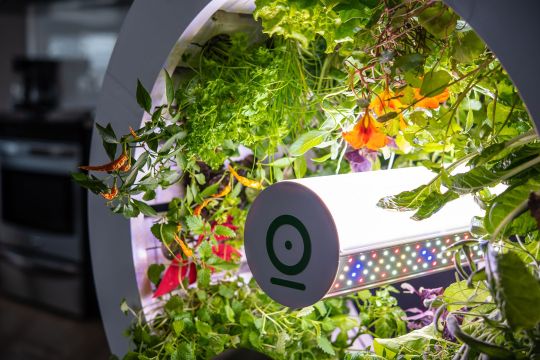
Transform your living space into a lush oasis of greenery and tranquility with a carefully designed smart indoor gardening system. Explore the key elements to consider when designing your indoor garden and discover how to create a harmonious and thriving environment for your plants.
Choosing the Right System: Selecting the perfect Smart Indoor Gardening System is the first step in creating your oasis. Consider factors such as size, style, and functionality to find a system that fits seamlessly into your home.
Whether you opt for a countertop herb garden, a vertical hydroponic setup, or a fully automated indoor greenhouse, choose a system that suits your space and gardening preferences.
Selecting Plants and Layout
Once you've chosen your system, it's time to select the plants that will inhabit your indoor garden. Consider factors such as light requirements, growth habits, and aesthetic appeal when choosing your greenery.
Experiment with different plant combinations and layouts to create visual interest and balance in your indoor garden, incorporating a mix of herbs, vegetables, and ornamental plants to suit your tastes.
Optimizing Light and Environmental Conditions
Light is essential for plant growth, so it's important to ensure that your indoor garden receives adequate illumination. Assess the natural light conditions in your home and supplement as needed with artificial lighting.
Position your indoor garden near windows or under grow lights to provide your plants with the optimal amount of light for healthy growth, and monitor environmental conditions such as temperature and humidity to create a comfortable and conducive environment.
Customizing Your System
Personalize your smart indoor gardening system to reflect your unique style and preferences. Add decorative elements such as planters, trellises, and decorative accents to enhance the visual appeal of your indoor garden.
Incorporate smart features such as automated watering systems, nutrient monitors, and remote control capabilities to streamline maintenance and ensure the health and vitality of your plants.
Creating a Maintenance Routine
Regular maintenance is key to keeping your indoor garden thriving. Develop a maintenance routine that includes tasks such as watering, pruning, and fertilizing to keep your plants healthy and happy.
Set reminders or schedule automated tasks to stay on top of maintenance chores, and take time to observe and interact with your plants to monitor their progress and address any issues that arise.
Designing your smart indoor gardening system is an opportunity to create a personalized oasis that brings beauty, tranquility, and vitality into your home. By carefully selecting plants, optimizing environmental conditions, and customizing your system to suit your style and preferences, you can create an indoor garden that nourishes the body, mind, and soul.
Get More Insights On This Topic: Smart Indoor Gardening System
#Smart Indoor Gardening System#Indoor Agriculture#Home Gardening Tech#Urban Farming#Automated Plant Care#Hydroponics#Indoor Herb Garden#Smart Home Devices#Sustainable Living
0 notes
Text
The Comprehensive Guide to Growing Hydroponic Strawberries in Desert Climates
Welcome to our in-depth exploration of growing hydroponic strawberries in the heart of the desert—a challenging yet immensely rewarding endeavor for gardeners and agricultural enthusiasts alike. Imagine, lush, ripe strawberries thriving in an environment known for its arid landscapes and scorching heat. This juxtaposition is not just a dream, but a reality made possible through the wonders of…

View On WordPress
#climate-adapted gardening#desert gardening#Eco-Friendly Gardening#fruit cultivation#gardening in arid climates#home hydroponics#hydroponic strawberries#Hydroponic systems#innovative farming techniques#nutrient management#Soil-less cultivation#strawberry varieties#sustainable agriculture#urban farming#water-efficient farming
1 note
·
View note
Text

Experience Fresh and Abundant Harvests with the Innovative Home Hydroponic Farming System
The Home Hydroponic Farming System boasts a range of impressive specifications that make it a game-changer in the world of indoor gardening. This compact and user-friendly system is designed to fit seamlessly into any home environment. Its dimensions of [insert dimensions] ensure that it can be placed conveniently in your kitchen, balcony, or even a small spare room.
0 notes
Text
0 notes
Text
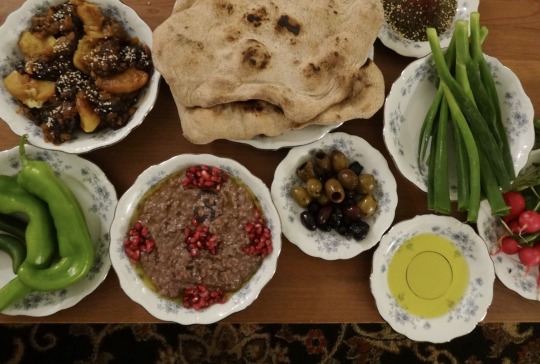
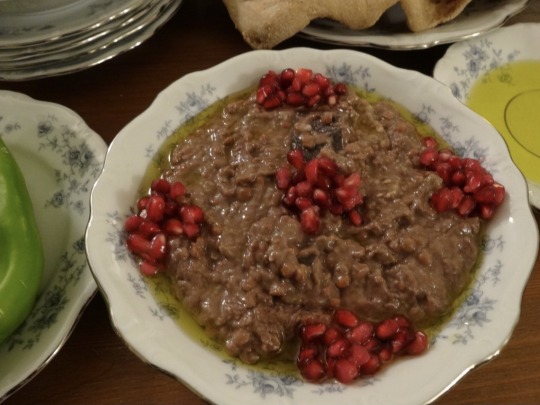
[ID: A purplish-grey stew topped with olive oil and garnished with piles of pomegranate seeds. Plates of green peppers, bitter olives, olive oil, taboon bread, green onions, radishes, and za'tar surround the dish. The second image is a close-up of the same stew. End ID]
رمانية / Rummāniyya (Palestinian pomegranate stew)
Rummaniyya (رُمَّانِيَّة; also transliterated "rumaniyya," "rummaniya," and "rummaniyeh") is a Palestinian stew or dip made from lentils, eggplant, and pomegranate seeds, flavored with nutty red tahina and a zesty, spicy دُقَّة (dugga) of dill seeds, garlic, and peppers. A طشة (ṭsha), or tempering, of olive oil and onion or garlic is sometimes added.
"Rummaniyya," roughly "pomegranate-y," comes from رُمَّان ("rummān") "pomegranate," plus the abstract noun suffix ـِيَّة ("iyya"); the dish is also known as حبّة رُمَّانَة ("ḥabbat rommāna"), or "pomegranate seeds." It is a seasonal dish that is made at the end of summer and the beginning of fall, when pomegranates are still green, unripe, and sour.
This stew is considered to be one of the most iconic, historic, and beloved of Palestinian dishes by people from Gaza, Yaffa, and Al-Ludd. Pomegranates—their seeds, their juice, and a thick syrup made from reducing the juice down—are integral to Palestinian cuisine and heritage, and images of them abound on ceramics and textiles. Pomegranates and their juice are sold from street carts and cafes in the West Bank and Gaza.
Today, tens of thousands of tons of pomegranates are grown and harvested by Israeli farmers on stolen Palestinian farmland; about half of the crop is exported, mainly to Europe. Meanwhile, Palestinians have a far easier time gaining permits to work on Israeli-owned farms than getting permission from the military to work land that is ostensibly theirs. These restrictions apply within several kilometers of Israel's claimed borders with Gaza and the West Bank, some of the most fertile land in the area; Palestinian farmers working in this zone risk being injured or killed by military fire.
Israel further restricts Palestinians' ability to work their farms and export crops by imposing tariffs, unexpectedly closing borders, shutting down and contaminating water supplies, spraying Palestinian crops with pesticides, bulldozing crops (including eggplant) when they are ready to be harvested, and bombing Palestinian farmland and generators. Though Palestinian goods have local markets, the sale of Palestinian crops to Israel was forbidden from 2007 to 2014 (when Israel accepted shipments of goods including tomato and eggplant).
Gazans have resisted these methods by disregarding orders to avoid the arable land near Israel's claimed borders, continuing to forage native plants, growing new spices and herbs for export, planting hydroponic rooftop gardens, crushing chalk and dried eggplants to produce calcium for plants, using fish excrement as fertilizer, creating water purification systems, and growing plants in saltwater. Resisting Israeli targeting of Palestinian food self-sufficiency has been necessary for practical and economic reasons, but also symbolizes the endurance of Palestinian culture, history, and identity.
Support Palestinian resistance by calling Elbit System's (Israel's primary weapons manufacturer) landlord; donating to Palestine Action's bail fund; and buying an e-Sim for distribution in Gaza.
Serves 6-8.
Ingredients:
For the stew:
1 medium eggplant (370g)
1 cup brown lentils (عدس اسود)
600g pomegranate seeds (to make 3 cups juice)
3 Tbsp all-purpose flour
1/4 cup red tahina
1/2 cup olive oil
Salt, to taste
Citric acid (ملح الليمون / حامِض ليمون) (optional)
Red tahina may be approximated with home cooking tools with the above-linked recipe; you may also toast white tahina in a skillet with a little olive oil, stirring often, until it becomes deeply golden brown.
For the دُقَّة (dugga / crushed condiment):
2 tsp cumin seeds, or ground cumin
1 1/2 Tbsp dill seeds ("locust eye" بذور الشبت / عين جرادة)
5 cloves garlic
1 green sweet pepper (فلفل بارد اخضر)
2 dried red chilis (فلفل شطة احمر)
People use red and green sweet and chili peppers in whatever combination they have on hand for this recipe; e.g. red and green chilis, just green chilis, just red chilis, or just green sweet peppers. Green sweet peppers and red chilis are the most common combination.
For the طشة (Tsha / tempering) (optional):
Olive oil
1 Tbsp minced garlic
Instructions:
1. Rinse and pick over lentils. In a large pot, simmer lentils, covered, in enough water to cover for about 8 minutes, or until half-tender.
2. Meanwhile, make the dugga by combining all ingredients in a mortar and pestle or food processor, and grinding until a coarse mixture forms.
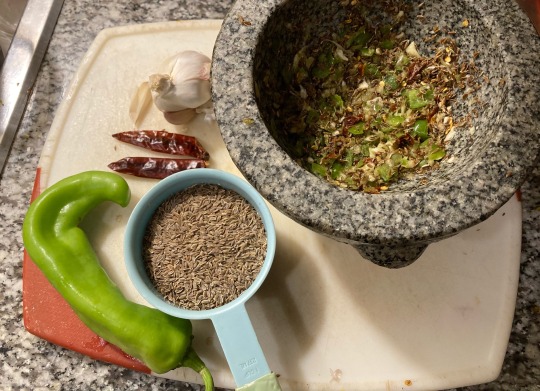
Dugga and components.
3. Cube eggplant. A medium-sized eggplant may be cut in half lengthwise (through the root), each half cut into thirds lengthwise, then cubed widthwise.
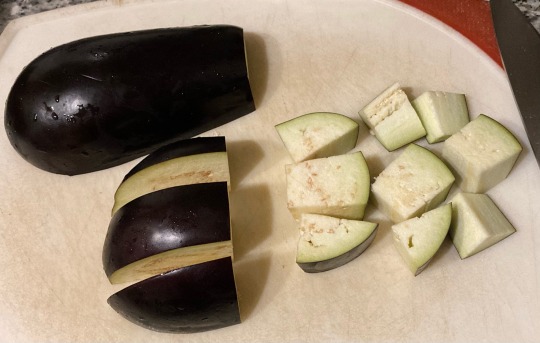
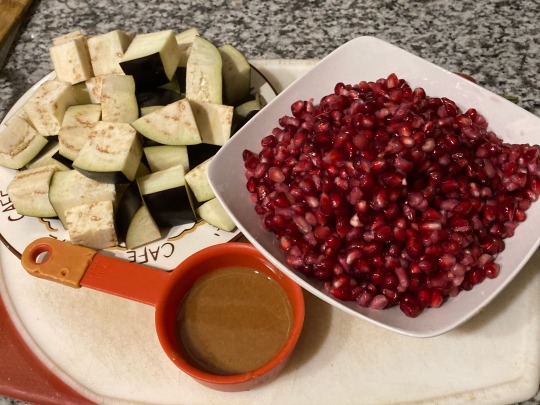
Cubed eggplant, red tahina, and pomegranate seeds.
4. Add eggplant to simmering water (there is no need to stir).
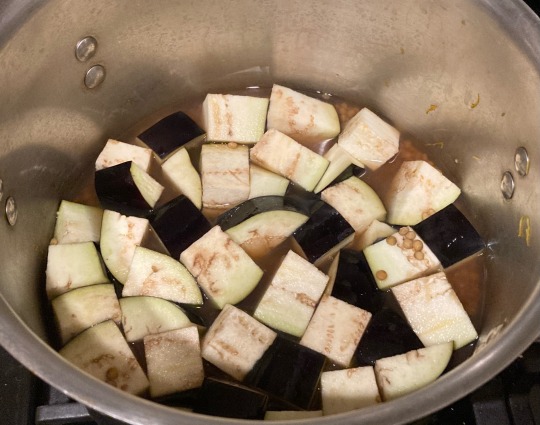
5. While the eggplant cooks, blend pomegranate seeds in a blender very thoroughly. Strain to remove any gritty residue. Whisk flour into pomegranate juice.
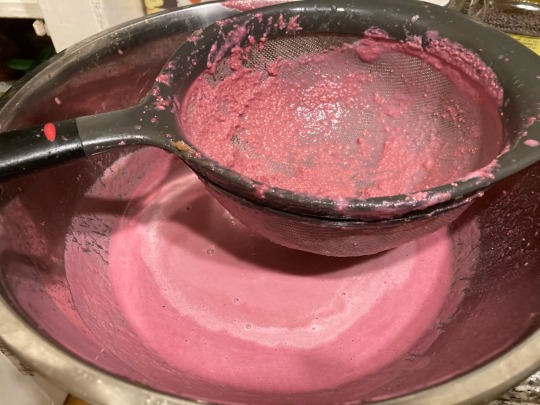
Pomegranate juice being strained.
6. Taste your pomegranate juice. If it is not sour, add a pinch of citric acid or a splash of lemon juice and stir.
7. Add dagga to the pot with the lentils and eggplant and stir. Continue to simmer until the eggplant is very tender and falling apart.
8. Add pomegranate juice, tahina, and olive oil to the pot, and simmer for another 5 minutes, or until stew is very thick and homogenous.
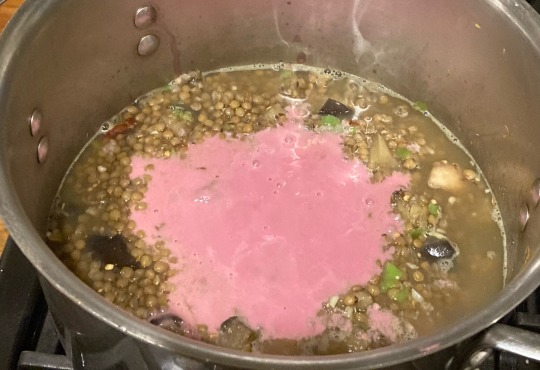
Bright pink pomegranate juice in stockpot.
9. (Optional) In a small skillet, heat a little olive oil on medium. Fry minced garlic, stirring constantly, until golden brown. Add into the pot and stir.
10. (Optional) Mash the stew with the bowl of a ladle or a bean masher to produce a more homogenous texture.
Serve rummaniyya hot or cold in individual serving bowls. It may be served as an appetizer, or as a main dish alongside flatbread, olives, and fresh vegetables such as radishes, green peppers, green onions, carrots, and romaine lettuce. It may be eaten with a spoon, or by using كماج (kmāj), a flatbread with an internal pocket, to scoop up each bite.
572 notes
·
View notes
Text

Comet's Log: Chao Garden
"I found what I think are like those dirt gardens that I’ve seen some Surfacers have back home. This one seems fancier though. There’s a rock formation with water just pouring out by itself, no pipes or anything; as well as some pretty plants. But, what’s really interesting are these tiny creatures that are living here. They have big heads and weird eyes that are kinda ugly (in a cute way)! They seem friendly enough too. Like, a few of them had sharp teeth, but nobody bit me or anything. Didn’t even really pay me any mind at all. My stomach rumbled real loud (I forgot I hadn’t eaten since before I got here!) all of a sudden. Then one of the little guys, a blue and yellow one, walked over with this weird fruit(?) in its teeny-tiny arms. It was trying to give it to me! How sweet! Unfortunately, I didn’t want to eat it because it might be poisonous. I tried to communicate that I didn’t want it, but the little guy insisted. A few more of them noticed and came over to see what was going on. I panicked, so…I just flew away and didn’t look back. I still feel kind of bad about it."

Extras below the cut:
I've decided to make the raw .clip layers available for download [HERE] for educational purposes. if y'all want it <3
Also! the purple chao is @genotaurus' Cloudy ✨
Some Edea lore notes:
Chao don't exist on Edea
Since she grew up in a space colony, Comet is only familiar with hydroponic farms/gardens. Dirt farms only exist on Edea's surface.
Also because of growing up on Ark Elysium, Comet barely has any experience interacting with "wild animals" or even pets in general.
#sonic oc#sonic fc#chao#my art#my ocs#comet's story#me? telling this story EXTREMELY out of order?#yes. yes I am ✨✨#this excerpt is part 4 out of (currently) 7#one day I'll compile it all properly#but a story told out of order is better than a story not told at all <3 peace and love#obligatory: i love drawing water and I LOVED working on that background#oc: comet the hedgehog
160 notes
·
View notes
Text
Looking for the Best Hydroponic NFT Channel | Inhydro

Hydroponic NFT Channels are a more complex Hydroponic system that can be used to grow larger plants like tomatoes and cucumbers. These systems involve a large reservoir connected to smaller tanks (known as channels) that house individual plants. Water is pumped from the reservoir into the channels using gravity-fed pumps and then circulated back into the reservoir.
#Hydroponic Nutrients#Hydroponic NFT Channel#Grow Light#Net Pots#Dutch Bucket#NFT Channel#Hydroponic Kitchen Gardening#Hydroponic Net Pots#Learn Hydroponic#Grow Lights#Hydroponic Companies in India#Hydroponic Farming India#Hydroponic Farming at Home#Hydroponics Training in Delhi
1 note
·
View note
Text


Maybe as a reward for repairing his friend, the creature showed Jack the hydroponics! The Boys are slowly running out of stocks - plus they have an additional (heavy) eater on board now ö.ö
The plants here are well cared of by the devices and bots - and already harvestable! Jack is fascinated by everything space and scifi and exploring alien plants is a long-held dream of his ^^' Jack called Jeb over, since the two of them are in charge of their greenhouse and garden at their home too. Jeb was still trying to repair the ship, but food has priority atm. He's is not quite as excited as Jack...

Jeb: "Only - we don't know any of these flora - and if they're edible. Sure, some of the harvestables look familiar, but they grow on these unfamiliar plants..." But he started to research anyway ^^'

Jack spotted the Sixam Fly Trap: "Well, I surely remember this little guy!"

(The Boys had a Sixam Fly Trap at the Invisible Farm in Summer 2023. Jack thought it was cute that it looked like Saiwa and he teased him with a photo of it ^^') It looks like this when it just snapped a fly. Being proud of himself.

'I've given you southern exposure To get you to thrive I've pinched you back hard Like I'm s'posed ta You're barely alive I've tried you at levels of moisture From desert to mud I've given you grow-lights And mineral supplements What do you want from me, blood?'
Little Shop of Horrors - Grow for me The MV linked above is from the Movie and the cutest thing!
Jack took a photo of this one too: "It's so cute! We could put the photo in your quarters." But Jeb stopped him. Sai is already stressed enough... (The post-it below the photo says: "Captain Saiwa II. Just as sharp-toothed and snappy as his namesake.")

Great A'Tuin's communication system still doesn't work (good job, alien creature...), so they have no access to external data or intergalactic search engines. But they could check the ship's internal database. And that's what they did. There they are! Sheets with information about all of the plants (created by Albaleyh herself when she used to work here). And they are all classified as edible. Some are even of medical use! Jeb: "After we resolved the food issue, we could check if any of them could be of help for Ji Ho's travel sickness!" Jack: "That would be awesome!"

Jeb and Jack picked a few of the strange vegetables and fruits and went over to the kitchen. Great A'Tuin's database even offers recipes and information about how to prepare them and which parts to use. Jack: "I really hope we don't end up like the poor little guys in those jars after eating these dishes... But somehow we'll have to find out if we can really eat them - and survive." For a moment Jeb considered if he should say goodbye to Saiwa before dinner ö.Ö'

But then the 'Curious Pizza' was ready to eat and Jack couldn't wait to taste it. It's been too long. Jack loves his pizza, no matter the toppings ^^'

Jeb: "Eh... if something happens. Tell Saiwa I love him." Jack: "Hey, let's keep a little optimism here!"


Lol, Jeb set the table with a flask of medicine for each ^^'

(And, of course, Jack refused to eat sitting at the table -.- I already replaced the tables and locked the door. Last time Kiyoshi and Jack ran outside... Next time I'd locked the door and they sat to eat on the cooler box or ate while standing omg... I mean, they already sit and have the food in front of them, why pick it up and go somewhere else?)

Jack: "But it was quite delicious! If we die, we die satisfied and well sated, hm?" If you have a friend like Jack, you don't need no enemies hahaha

Outtakes
Jack already had a stressful day. And on top of that, Greg called him ^^' He surely does not want to be like Greg - ever! And the only one to ever put an effort in trying to raise Jack was Uncle Stefan. (And Saiwa hahaha)

And then the first of his 'Curious Pizza' vanished right from the oven! So he had to make another one... Maybe the creature will find it ^^' Or the Boys - when it starts to smell ö.ö (I already wondered why Sai is complaing in the pic above. There is no dirt ö.ö (edit: It was a bunch of hairs from the cat creature, which was just as grey as the spaceship's floor...)

From the Beginning 🔱 Underwater Love 🔱 Latest
Current Chapter: starts ▶️ here Last Chapter: 'Here comes the Sun' from the beginning ▶️ here
📚 Previous Chapters: Chapters: 1-6 ~ 7-12 ~ 13-16 ~ 23-29
#underwater love#Piglets in Space#jack callahan#Lenny Andromedan#jeb harris#Great A'Tuin II#Jack pizza#simlit#Jack hates Greg#sims 4 story#sims story#the sims 4#simblr#sims 4#ts4 story#ts4
33 notes
·
View notes
Text
Hydroponic Farming at Home
Hydroponic farming is a soilless farming technique that has gained popularity in recent years due to its numerous benefits. With hydroponics, it is possible to grow a wide variety of plants, including fruits, vegetables, herbs, and flowers, using water and nutrient-rich solutions. This innovative approach to agriculture is not only sustainable and cost-effective but also allows for year-round cultivation regardless of location or climate.
Higronics is a company that specializes in hydroponic farming solutions for home use. They offer a range of products that cater to both beginner and experienced hydroponic enthusiasts. One of their main products is a compact hydroponic system that can be easily set up in small spaces such as apartments, balconies, and rooftops.
The Higronics hydroponic system consists of a reservoir, pump, grow tray, and nutrient solution. Plants are placed in net cups, which are suspended above the nutrient-rich water, allowing the roots to absorb the necessary nutrients. The system is fully automated, with a timer that controls the pump, ensuring that the plants receive the right amount of water and nutrients at the right time.

One of the advantages of the Higronics hydroponic system is its efficiency. Since the system recirculates water and nutrients, it uses up to 90% less water than traditional soil-based farming. The system is also designed to be energy-efficient, using LED grow lights that consume minimal electricity.
Another benefit of hydroponic farming with Higronics is that it allows for faster and more abundant plant growth. The system provides a controlled environment, with optimal temperature, pH levels, and nutrient levels. This results in healthier plants that grow faster and yield more produce than traditional farming methods.
Hydroponic farming with Higronics also offers the advantage of being able to grow a wide variety of plants in a small space. With the right setup, it is possible to grow multiple crops at the same time, increasing productivity and maximizing space utilization.
0 notes
Text
....solarpunk makes a conscious choice to envision a plausible world focused on spirituality, craftsmanship, community, and natural/technological harmony — all powered by renewable energy.
So, what does solarpunk farming look like when practiced by real-life adherents?
To Navarre Bartz, former Charlottesville director of the Thomas Jefferson Soil and Water Conservation District, “Solarpunk farming has to be regenerative. Whether through permaculture, healthy soils, or something else, solarpunk agriculture keeps biological cycles going and ideally leaves the land and water around it healthier than when you started.”
Farmer Andreas George, known to his followers as Solarpunk Farmer, has amassed tens of thousands of followers across all his accounts, with whom he shares videos explaining how the average American can implement these practices on their farms.
George launched his social media identity to promote small-scale aquaponics technology, initially his primary focus. This methodology involves farming fish and plants in a recirculating aquatic ecosystem without using soil. However, many of the practices he now teaches and advocates for (such as cover crops, companion planting, sheet composting, and deep mulching) fall under a “regenerative agriculture” umbrella and are seeing a rise in popularity — no matter what name they fall under.
“I think that as long as you’re trying to improve your surroundings by growing things, that makes you [a solarpunk farmer].”
“People are beginning to realize just how easy and effective covering your soil with mulch is at retaining water and conserving nutrients, for example,” said George. “Cover cropping, which greatly improves soil health and supports insect biodiversity, is a traditional farming practice dating back thousands of years, which is now displacing the use of factory-produced fertilizers and soil amendments in home gardens and giant industrial farms alike.”
While George still advocates for aquaponics, he only considers them solarpunk when applied in an urban setting on a small scale. (There are plenty of disputes as to what is and isn’t true solarpunk on Reddit’s r/solarpunk, a 129,000+ member subreddit.) To condense his thinking, aquaponics and hydroponics are simply too costly when scaled up. They are only practical and environmentally responsible when used in limited, clean soil spaces for serving individual communities.
24 notes
·
View notes
Note
hi acti, shits pretty bleak in the U.S. at the moment. I'm very proud of my folks for voting 93 and 80% majority for blue but it's not enough. We're taking this time to just rest and try to think of ways to brace for what's coming. Especially with FDA and health inspection rollbacks in place. My family's majority plant-based save for my mom. Idk if u remember or if u had gotten it, but I wrote an anonymous message a long time ago asking if there was a way to transition my mom from backyard egg vegetarianism with rescue hens to veganism, especially since I don't think we can trust animal products soon. I really want to start a micro farm, (like a freight hydroponics microfarm or something similar) if possible because soon I won't trust the soil from big box stores as I can't sterilize it enough nor grow year round and its gonna be a rough 4 years and up. I'm just looking for hobbies to help feed my community if anything.
(Im so sorry if this seems like the beginning manifesto of an online recipe) but Do you happen to have any sources on vegan alternatives to beekeeping? Or any sources on sustainable indoor hydroponic farming that could feed several people? Or if you think its best to keep rescue chickens for eggs and transition my mom to plant-based sources for her own safety now? Thank u in advance
I want to preface this by saying I don't really have any personal experience with this, so my answer here is based solely on research. It will depend on the level of space you have in your home, but even if you have a couple of spare rooms to use, I think you'll need to manage your expectations a little bit.
It is unlikely that you'll be able to become self-sufficient unless you have access to a plot of land. What you'll be growing will supplement what you're buying, but it won't replace it. Communal allotments could be an option, but that will depend heavily on where you are and how available they are, as well. Even then, the quantity you'll produce on a small allotment will not be enough to feed several people.
That said, you can grow quite a lot indoors or on a small plot of land, and you'll certainly be able to provide a real boost of fresh fruit and veg, either to community kitchens or to your family. I don't think that having animal inputs would really provide much of a benefit since you'd also have to rely on buying or growing feed, so my recommendation would be to just start with trying to supplement what you're buying now, with easy options to grow at home.
As for resources, here is highly rated book on vegetable gardening, if you do have access to an outdoor space. For indoor, this is supposed to be a good entry level book, here is a more extensive text focused on soiless growing, and here is one focused on equipment. There are also a couple of active subreddits on this, but I think that these four combined should provide a really good foundation to get you going - but it is apparently a lot of trial and error, and you will need to set some money aside for an initial investment into your equipment.
I think that it's a great idea so start to look towards growing your own food, but don't get too wrapped up in the self-sufficiency idea. Reach out to local growers and grower communities, make connections at farmers markets, see if you can do any work in community gardens to learn. Community is what is going to get people through this, and making those connections now would be wise.
Edit: Check this advice from a knowledgeable anon as well.
16 notes
·
View notes